Why does Surah Ar-Rahman start with the divine attribute of “Ar-Rahman”?
The following are brief extracts of the interpretation of the first few Quranic verses of Surah Ar-Rahman from Tafheem Al-Quran by Sayid Abul A’la Moududi. It touches on the topic as to why Sura Ar-Rahman starts with the divine attribute of “Ar-Rahman”?
IN ARABIC THE WORD REHMAN IS ONLY 4 LETTERS = RHMN, QURAN ALSO 4 LETTERS the letters in English will change, same with ENSAN AND BAYAN IN ARABIC ALL 4 LETTERS. ALL EQUAL TO THE WARD OF ALLAH IN ARABIC ALSO 4 LETTERS FROM God and his Quran to human to gain wisdom and knowledge. ha mem mentioned 6 times, noon mentiond one time in quran.
ALR ALSO IS THE KEY WORDS FOR OD NAME BRAHMAN, ALRAHEEM, ALM is key word for God name such as almomen, almohaymen and so on for all those key letters in the start of each of some chapters are in fact is the God name characteristic as we know him the God with 99 names .
Surah Rahman – Verse 2 – Interpretation of Surah Ar-Rahman (“He has taught (mankind) the Quran (by His mercy).”)
One meaning that can be deduced from this verse is that Prophet Muhammad (upon whom be Allah’s peace and blessings) himself is not its author, but Allah Almighty is the teacher. Furthermore, if the purpose was only to say that that teaching is from Allah, and not from the Prophet’s mind, then there was no need to use an attribute of Allah (such as Ar-Rahman) instead of His proper name (Allah), as for that purpose any attribute from among the Divine attributes could have been adopted.
But when, instead of saying that Allah, or the Creator, has taught this, it was said: ‘The Merciful (Ar-Rahman) has taught this Qur’an. So, it gave the meaning that the revelation of the Qur’an for the guidance of mankind was nothing but Allah’s mercy and grace. As He is most kind and Merciful to His creation, He did not like that He should leave them wandering in darkness. Instead, His mercy demanded that He should send down this Quran to (give) them the knowledge on which depends their right guidance and conduct in the world and their success and well-being in the Hereafter.”
Surah Rahman – Verse 3 interpretation of Surah Ar-Rahman (“He Created Man.”)
In other words, as Allah is the Creator of man, and it is the Creator’s responsibility to provide guidance to His creation and show it the way by following which it may fulfill the object of its creation. Who else would provide guidance to the creation if not the Creator? And if the Creator did not provide guidance, who else could? And what greater defect could there be for a creator that he should not teach his creation the method of fulfilling the object, for which it has been created?

Surah Rahman – Verse 4 interpretation of Surah Ar-Rahman (“He taught him eloquent speech”)
One meaning of the word ‘bayan’ is the expressing of one’s own mind, i e. speaking and expressing one’s thoughts and intentions. Its other meaning is to make distinction between things, which here signifies the distinction between good and evil, virtue and vice. About ‘bayan’, ibn Al-Kathir reported that Al-Hasan said: “Eloquent speech.” This refers to Allah teaching the Qur’an, that is, teaching the servants how to recite it by making it easy for them to speak and pronounce letters with the various parts of the mouth, such as the alveolar bridge, the tongue and the lips.
Steve Ramsey – Okotoks – Canada
There are too many questions raised around the letters which some chapters start with: why did Allah put these letters in His book, and is it about the time when Allah will bless us with the understanding of these letters, but can these letters be a strong, concrete proof to the truthfulness of Allah in this era of numeric tech.???
That is what we will see through the meticulousness of these letters’ accurate numeric structure which again shows us how complicated yet wonderful Allah’s words are, and that nobody can bring something alike. What we will see is a beautiful harmony of numeric coordination based on number 7 and its multiples according to a scientific, numeric method.
In this research, we will deal initially with the first mentioned letters which are ‘Alif Lam Mim’. Thus, when will come to discover their meticulousness, we will move to look after other letters’ miracles because each koranic letter contains a miracle.
First, we need to call these letters ‘the special letters’ as Allah has chosen to be as such and to be the opening of some chapters. They are 14 letters ( 14 is a multiple of 7!) and even their repetitions are based on number 7.
What scholars, may Allah have mercy upon them, first noticed was that the number of these letters is 14 and they came in 14 openings ( we exclude the repeated openings). What has interested me the most is this number 14, which I thought should contain the whole matter, as it was mentioned twice :
- The special letters are 14.
- The openings are 14.
14 is about 7 multiplied by 2: 14= 7 × 2. so what can this mean?
Before we look over the significations of this number, I would like to correct the name that is given to these letters: the chop letters. This is not accurate at all scientifically as they are written down linked and not separately.
Some would also call these letters ‘the lighting letters’, do you think that other letters are dark?! Likewise, and after a long searching I came to know that these letters are right to be called ‘the special letters’ because Allah has chosen them to be the opening of almost the quarter of the Koran.
Therefore, we are going to use this name all along this research, and the openings that some chapters have started with as ‘alif lam mim’, ‘alif lam mim sad’… will be called ‘the special openings’, and even the chapters which contains this kind of letters can be called ‘the special chapters’. After all, we have to ask ‘why is it about 7?’
The special number:
Nobody ignores the wonders and the secrets of the number 7. It is the first number mentioned in the Koran, the most repeated number in the Koran after number 1, the number Allah has chosen for every atom in this universe: the number of the layers of the atom is 7, the number of the heavens is 7, the earths are seven, the days of the week are 7…etc.
Even our prophet (peace be upon him) was often repeating this number. We turn around the Ka’bah 7 times; the walking between Safa and Marwa for is 7 times; the stones we throw on Satan in Pilgrimage are seven; we prostrate on seven bones… and if ever we look after the significance behind this number, we need thousands of big registers to write them down.
Allah, then, has chosen a number of special openings double to 7: 7 × 2, but what can number 2 represent? 2 means duplication, as if Lord wants us to discover the miracle behind these letters based on 7 and its repetitions, and He made them 7 by 2. ( two represents the multiplication). i.e. if we analyse these special letters and the way they are ranged and structured all through the verses and the chapters, we should come to a lot of coordination between these letters and number 7; mathematically speaking, we must have numbers that can be divided by 7, and this is what we will see together.
Thus, I started years ago to analyse these letters and study them in what concerns their repetition and distribution in the verses and the chapters; I only found a marvellous, accurate system. I, then, wrote a whole book entitled The secrets of ‘Ali Lam Mim’s miracle where I tackled the miracles of these three letters with detail. It was certainly a conviction that these letters contain a numeric miracle based on number 7 and its multiples; so let us start with the first ‘special’ letters of the Koran.
The first opening in the Koran:
The very first opening fragment in Koran is ‘alif lam mim’, and which is the first verse of ‘The Cow’ chapter. Right after this verse, or opening, comes a confirmation from Allah that this book ‘Koran’ contains no suspicion, i.e. no doubt does it carries and in fact, it is guidance to the righteous. Allah says: “alif lam mim, That book contains no suspicion in it. It is guidance to the righteous” (1-2 The Cow chapter).
If we go to the last chapter which contains this special opening fragment, that is ‘The Prostration’ chapter, we will find that right after the opening comes a verse where Allah confirms the certainty of this book again, and that it is a revelation from Him. Allah says: “ The revelation of the book is from the Lord of mankind” (The Prostration chapter). There is always this affirmation that Koran contains no doubt.
I thought for a long time about the secret of this repetition, and why did Allah chose these three letters out of tens of others? Then, after a long searching I had an idea on my mind which told me that Allah did not choose these letters by random, and they might represent one of His names or names of chapters. All of these has not been proved yet because if one would change these letters the interpretation of the verses and the chapters would not change, i.e. these letters can be names of Allah or of chapters.
The logic would just lead us to think that Allah did not put these letters in His book haphazardly, but deliberately to make us sure about the special construction these letters are based on: if ever we change one of these letters, the whole structure will change; which means that these letters contain a miracle that allows no change in the structure of these openings. Then we ask ourselves: ‘how can we express this very précised structure? And will we find any coordination with n° 7 within this structure?
To get a good result, I have followed a scientific method in studying these letters, thus I started with answering this question : ‘as long as Allah these special letters to open some chapters with so that a next verse would talk about the certitude of His Book, then is it possible to find that in these letters’ structure a proof to the sureness of the divinity of Koran?
A wonderful distribution of the special letters:
I have written the second verse of ‘The Cow’ chapter as it is written down in Koran, and under each word I put the number of the letters (alif lam mim); see what I have written:
“That book contains no suspicion in it. It is guidance to the righteous”
ذَلِكَ الْكِتَبُ لا رَيْبَ فِيهِ هُدًى لِلْمُتَّقِينَ
3 0 0 0 2 2 1
We read then the number 3000221; this number has a relationship with 7 as it is a multiple of 7. If we divide 3000221 by 7, we will get an exact number:
3000221 = 7 × 428603
So the number which represents the distribution of the letters (alif lam mim) is a multiple of 7; but what about the last (alif lam mim), the one we find in ‘The Prostration’ chapter? Can we have the same relationship?
We write again the verse that follows these letters, and we cont the number of them (alif lam mim) in each word, we also notice that ‘the book’ ,in Arabic, was written without ‘alif’ in the middle as ‘mankind’, this is a secret behind a wisdom we will discover part of it later.
“The revelation of the book is not uncertain, from the Lord of mankind”
تَنْزِيلُ الْكِتَبِ لا رَيْبَ فِيهِ مِنْ رَبِّ الْعَلَمِينَ
4 0 1 0 0 2 2 1
We read the number 4100221, which represents the distribution of the special letters within this verse. It is a multiple of 7:
40100221 = 7 × 5728603
We see now; this exact sevened distribution has not come by chance, as chance could not be repeated as such. This makes sure that the distributions are not only for letters, but also the words do have a special structure. Let us read the next paragraph:
A wonderful distribution for the words:
In the previous two letters, we had words containing ‘alif lam mim’ and words not. I ask ‘ if the distribution of these letters within the verse and in all the words is related to number seven, what about the words that contain the letters? Do we have the same relationship?’
We say: “ as the letters ‘alif lam mim’ have been distributed according to a structure based on number seven, the words which contain them too are distributed in the same way.” We write again the two verses; we put number 1 for the words that contain these letters and 0 for the words, which do not contain them, and this is a well-known mathematic method based only on 1 and 0:
“That book contains no suspicion in it. It is guidance to the righteous”
ذَلِكَ الْكِتَبُ لا رَيْبَ فِيهِ هُدًى لِلْمُتَّقِينَ
1 0 0 0 1 1 1
We read number 1000111; it is a multiple of 7:
1000111 = 7 × 142873
The same we find for the second verse of ‘The Prostration’ chapter:
“The revelation of the book is not uncertain, from the Lord of mankind”
تَنْزِيلُ الْكِتَبِ لَا رَيْبَ فِيهِ مِنْ رَبِّ الْعَلَمِينَ
1 0 1 0 0 1 1 1
11100101 again is a multiple of 7!
10100111 = 7 × 1442873
Dear reader didn’t you see this miraculous distributions based on number 7! Do you think it is possible that these distributions came by random? And if ever, is it possible that this random would be repeated in all the verse of the Koran?
A miraculous coordination:
The numeric miracle of Koran does not stop at the level of the verses but even the relationships between the verses have a meaning because of the perfection of this book. If we count the letters of the first verse, we find 26, and the second is about 29 letters. What is wonderful here is that these two numbers do coordinate with 7, if we range them one next to the other:
The last verse The first verse
29 26
2926 is multiple of 7:
2926 = 7 × 418
This result would prove the relationship between the letters of the verse and 7. Moreover, we have another wonderful relationship between the letters of the verses and the words, which contain ‘alif lam mim’.
A marvellous balance between the letters and the words:
The number of the words, which contain ‘alif lam mim’ in the first verse, is 4 and the number of ‘alif lam mim’ in this verse is 8, i.e. the double. Then, it is surprising to know that both have a relationship between them:
- The number of the words containing “ALM” = 4
- The number of ‘alif lam mim’ letters in the verse = 8
84 is a number multiple of 7:
84 = 7 × 12 (notice that number 12 = 8 + 4)
For the last verse, we find that the number of the words containing ‘alif lam mim’ is about 5 and the number of these letters is 10! It is about the double! And it is about the same thing as in the first verse!
- The number of the words containing “ALM” = 5
- The number of ‘alif lam mim’ letters in the verse = 10
84 is a number multiple of 7:
105= 7 × 15 (notice that number 15 = 10 + 5)
Even the numbers resulted in the two operations are related; 15 next to 12 gives 1512, which is a multiple of 7:
1510 = 7 × 216
The last number, 216, is wonderfully coordinated with the number of the chapters that contain as an opening ‘alif lam mim’, 6:
216 = 6 × 6 × 6
Therefore, we have to be convinced that each number Allah has put in His holy book is miraculous!
A miraculous drawing:
Koran is miraculous even in the way its words and letters are written. Thus, dear reader notice the wisdom of Allah who has inspired Muslims to write the word ‘book’/ ‘kitab’ without ‘alif’(A in Arabic) in the two previous verses if we just know that in other verses it was not dropped! And notice then, if someone tried to add it there would be no more the same coordination.
Isn’t it a proof that Allah has protected His book? We have without doubt sent down the Message; and We will assuredly guard it (from corruption) [15 : 9]
A marvellous repetition of the letters:
If one would analyse the letters and the words of Koran, he should encounter the same truth: a wonderful system, then we must confess how Almighty and Powerful Allah is. It is enough to know that ‘alif lam mim’ was repeated in the first verse in a miraculous way. If we count the number of these letters in this verse (in the name of Allah Most Gracious Most Merciful) we find 3 for ‘alif’ 4 for ‘lam’ and 3 for ‘mim’, we read:
M L A
3 4 3
We read number 343 which is a multiple of 7 for 3 times:
343 = 7 × 7 × 7
The last number is 1, and the number of this verse is also 1 and the chapter is number 1!!! Isn’t it a marvellous result which can be a proof to the oneness of Allah?
I still wonder: ‘why was this fragment ‘alif lam mim’ repeated six times in Koran? And why did Allah choose some chapters to start with these letters?
Let us write all the chapters that start with special letters:
An amazing ordering of the chapters beginning with ‘alif lam mim’:
As we have mentioned, in Koran there are 6 chapters starting with ‘alif lam mim’, so is there any structure built on number 7? Allah has , with His Power and Wisdom, chosen a perfect system for the Koranic chapters mainly those starting with ‘alif lam mim’. Therefore, we must ask ourselves ‘what is the wisdom behind this repetition of letters? And why did the choice include some long chapters and other short ones? Then why there are four revealed Mecca chapters (The Spider, The Rum, Luqman, The Prostration) and two other revealed in Medina (The Cow and ‘The Family of Imrane’)
Now, we are going to answer these questions with some mathematic, scientific certain proofs.
The first reality:
Why does the verse ‘alif lam mim’ take number one in all the chapters it was mentioned in? the reason to this is the existence of a structure based on number 7:
If we range number 1 for six times (referring to the number of chapters containing these letters):
1 (The Cow) 1 (Imrane Family) 1 (The Spider) 1(The Rum) 1(Luqman) 1( The Prostration)
111111 is a number multiple of 7:
111111 = 7 × 15873
The second reality:
The chapters containing this fragment ‘alif lam mim’ were chosen by The All-Knower to have a miraculous position among the 29 chapters starting with special letters so that if we range their numbers, we will have a number multiple of 7, like this way:
- The Cow = 1
- Imrane Family = 2
- The Spider = 15
- The Rum = 16
- Luqman = 17
- The Prostration =18
The number 1817161521 is a number multiple of 7 for three times, look!
18 17 16 15 2 1 = 7 × 7 × 7 × 5297847
Even the last number 5297847 is constituted with 7 classes, and when we gather them we have a number multiple of 7!
5 + 2 + 9 + 7 + 8 + 4 + 7 = 42 = 7 × 6
Dear reader don’t you notice that we had at last number 6. Why? We do not have to forget that chapters starting with ‘alif lam mim’ are 6.
The third reality:
The two chapters revealed on dear prophet Mohamed (p.b.u.h.) in Medina, The Cow and Imrane Family takes the positions 1 and 2 respectively. 2 next to 1 gives 21, which is a multiple of 7:
21 = 7 × 3
What about the other chapters starting with ‘alif lam mim’? the other chapters, revealed in Mecca, are positioned as following: 15,16,17 and 18; again the resulting number is a multiple of 7!
18 17 16 15 = 7 × 2595945
Both kinds of the above chapters do coordinate with number 7! More than this, if we look in The Holy Book of Koran we read two groups of chapters beginning with ‘alif lam mim’: two successive ones (The Cow and Imrane Family), and four successive ones (The Spider, The Rum, Luqman, The Prostration).
If we range them, we will have such a big surprise:
The second group The first group
4 2
42 is a multiple of 7:
42 = 7 × 6
And 6 is the number of these chapters!!
The fourth reality:
Now we try with the number of the verses of each chapter; we write:
- The Cow = 286
- Imrane Family = 200
- The Spider = 69
- The Rum = 60
- Luqman = 34
- The Prostration = 30
These numbers, ranged one next to the other, give a number multiple of 7:
30 34 60 69 200 286 = 7 × 4335152742898
If we gather the numbers of the verses, we will have a number multiple of 7 too!
30 + 34 + 60 + 69 + 200 + 286 = 679 = 7 × 97
Then if we only gather the numbers, we will get again and again a number multiple of 7!!
3 + 0 + 3 + 4 + 6 + 0 + 6 + 9 +2 + 0 + 0 + 2 + 8 + 6 = 49 = 7 × 7
Notice, dear reader, that the mathematic operation we wrote stopped at a double number of 7!! Don’t these results give us a clear, logic explanation about the existence of these numbers and that we, mankind, are unable to produce such coordinations?!
What is more?
After more than 20 operations, we say there still more to discover and to find out about more coordinations with number 7.
I have to ask anyone who denies the divinity of the Koran: was Mohamed (p.b.u.h.) a specialist in mathematics and in the numeric series? Had he such big modern machines to calculate great numbers as we had? Or it He, The Almighty, who has put this perfect numeric structure in His Book?
The results we had make sure that if ever there’ll be a letter missing, a chapter moved, a verse changed, we will no more have the same miraculous structure! Aren’t these letters and numbers a strong proof in this age of materialism that Allah has protected His book from any deviation?
These explanations are built on strong mathematic rules and accurate, numeric series which are in fact tools to prove that it is Allah who has put these letters in such perfect way.
What is the aim behind these letters chosen as openings?
We may say that the wisdom behind this is in fact the existence of the miracle itself. The miracle of these letters is a proof to the divinity of Koran, as no human being can ever bring such perfect structures. Moreover, these letters proves the impossibility of the production of such miraculous book. No Man is able to produce a book where he would control its letters, numbers and chapters so that all is based on the same number. The third aim behind these letters is the proof that Koran has not been changed because of the perfection of its structure.
Why have some letters been repeated and some haven’t been?
Some letters have been repeated and others not to have more coordination and miracles, as we have seen for the repetition of ‘alif lam mim’.
Allah wanted that these miraculous letters would be a reason behind the conversion of many non-Muslims into Islam, who are wise and intellectual. They (the letters) also can be a reason behind the withstanding of the believers in such era, for they can be proud of their Book and Religion.
Is it all?
This is only one example from other thousands of miracles Koran contains. I claim that Allah has distributed all the letters of His book in the same incredible way. It is too much to talk about more miracles of the ‘special letters’ in one research.
To know more about the ‘special letters’, we invite you dear reader to have a look at the book ‘The Secrets of Alif Lam Mim’s Miracle’ that is available on this web site. Then to know more about the miracles of number 7 in the Koran,
The Mystery Letters of Quran (Huroof-al-Muqattaat)
This thesis attempts to investigate the mystery letters of Quran called the “Huroof-al-Muqattaat”. Here, the hermetic arts of astrology, alchemy, and symbolism are employed to decipher their meanings, and potential significance for the human spiritual growth.

The extraordinary perfection in the design of universe has flabbergasted human intelligence since time immemorial. Notwithstanding the immense complexity of living organisms in nature, the indefatigable human spirit of enquiry led to the comprehension of definite principles for satiating the need for clarity in their affairs; because out of all creatures, humans have always wanted to be the smartest by grasping the knowledge of everything, and thereby controlling the very gist of existence. But not everyone in the family of human race were either talented or heroic enough to be raised at the level of consciousness that those creative agencies of cosmos acted with, and hence their languages got divided into ‘exoteric’ and ‘esoteric’ expressions or terminologies. The adepts throughout ages often used encoded symbols and hieroglyphs in their communications to transmit the insights to posterity in order to guard them from self destructive human behaviours. The realization of extremely intricate and fragile existence of life on planet Earth, which is also the home to humanity, not only made it necessary to act with utmost responsibility for keeping the natural balance, but also to embrace a role of directing the course of humanity towards best consequences.
Like many ancient texts that were meant for guidance to humanity, the Quran seems to be a book designed for the specific purpose of raising consciousness in human beings. There are definite evidences of esoteric teachings in the texts of Quran, and despite of it being studied through a millennium, many of those teachings still evade proper explanation. An example of such texts is the ‘Mystery Abbreviated Letters’ of the Quran, popularly known as the “Huroof-al-Muqattaat”. Therefore, in this article I have endeavoured to describe their meanings in the context of Quranic teachings.
The Mystery Abbreviated Letters (Huroof-al-Muqattaat)
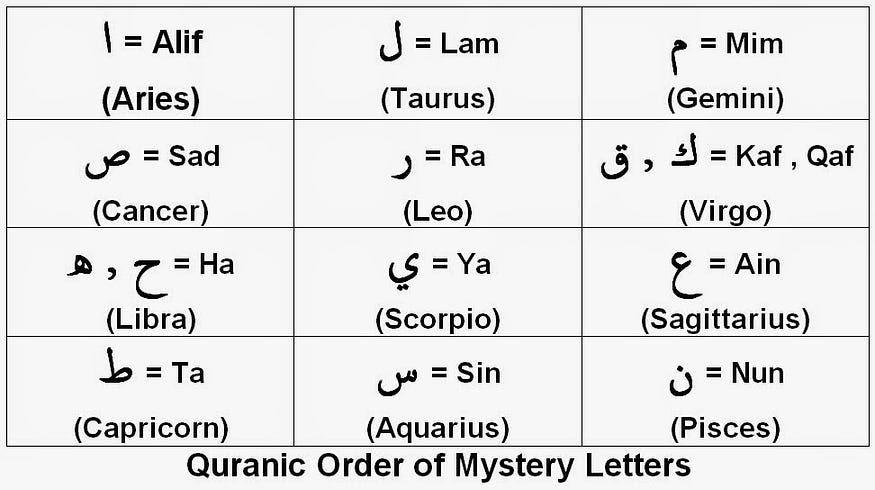
These mystery letters comprise of the Arabic alphabets mentioned in the table, and though they do not appear in the alphabetical order in the Quran, but are actually stated as prefixes to certain chapters of the book. Throughout the Muslim history, there have been many theories proposed to justify their existence in Quran. A few had suggested that they were initials of the scribes who had written down the dictation of those chapters, whilst others commented on them to be of some especial mystical significance which is known only to God himself. The Letters appear in Quran successively in the following fashion.
Alif, Lam, Mim @ Chapters 2, 3, 29, 30, 31, 32.
Alif, Lam, Mim, Sad @ Chapter 7.
Alif, Lam, Ra @ Chapters 10, 11, 12, 14, 15.
Alif, Lam, Mim, Ra @ Chapter. 13.
Kaf, Ha, Ya, Ain, Sad @ Chapter 19.
Ta, Ha @ Chapter 20.
Ta, Sin, Mim @ Chapters 26, 28.
Ta, Sin @ Chapter 27.
Ya, Sin @ Chapter 36.
Sad @ Chapter 38.
Ha, Mim @ Chapters 40, 41, 43, 44, 45, 46.
Ha, Mim, Ain, Sin, Qaf @ Chapter 42.
Qaf @ Chapter 50.
Nun @ Chapter 68.
The most prominent Muslim scholar on the interpretation of the Quran, Allama Abdullah Yusuf Ali, had explained about these abbreviated letters in his commentary that,
“Certain Surahs have certain initials prefixed to them, which are called the “Abbreviated Letters”. A number of conjectures have been made as to their meaning. Opinions are divided as to the exact meaning of each particular letter or combination of letters, and it is agreed that only Allah knows their exact meaning.
Their presence is not inconsistent with the character of the Quran as a ‘plain book’. The book of nature is also a plain book, but how few can fully understand it? Everyone can get out of the Quran’s plain guidance for his life according to his capacity for spiritual understanding. As his capacity grows, so will his understanding grow. The whole Book is a record for all time. It must necessarily contain truths that only gradually unfold themselves to humanity.” (Appendix 1. Commentary on Quran by Allama Abdullah Yusuf Ali)
There are 29 chapters of the Quran that mention the abbreviated prefixes. The 14 letters out of 28 alphabets of Arabic language are used in different combinations in those prefixes among which two pairs are homophonic, i.e. different glyphs with the same sounds; hence making them 12 sound characters in total because each of the homophonic pair of letters here act as one character. I propose in the ensuing discussions that these 12 characters appear in a definite order in the Quran which corresponds to the 12 astrological signs, and such that the features of prefixed signatures as astrological signs form the subject of discussion in the associated chapters. In other words, these abbreviated prefixes summarize the chapters themselves, and letters in the order of appearance in Quran represent the 12 astrological signs. These letters are indicated in the attached table alongside their corresponding signs.
The Letter ‘Alif’ (Aries)
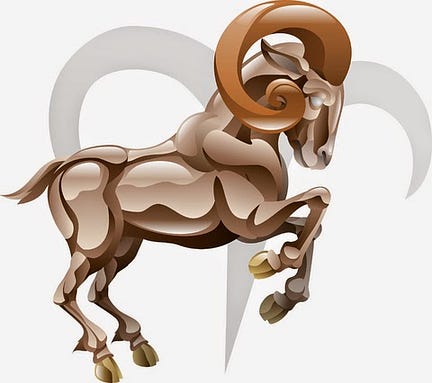
The letter ‘Alif’ appears as a prefix in the beginning of the second chapter of the Quran, and therefore, it is the first letter of the Quranic sequence. Astrologically it refers to the sign of Aries, as it signifies the subject of warfare in the Quran. Also, the fighting of wars was proclaimed for the first time in this chapter of the Quran, which is akin to the archetype of the sign of Aries. The Quran states,
“Warfare is ordained for you, though it is hateful unto you; but it may happen that ye hate a thing which is good for you, and it may happen that ye love a thing which is bad for you. Allah knoweth, ye know not.” (2, 216)
A scholar of Quran, Mohammed Marmaduke Pickthall has written the following in his commentary on this chapter.
“All suggestions to the contrary notwithstanding, it seems probable that the whole of this surah was revealed during the first four years after the Hijrah, and that by far the greater portion of it was revealed in the first eighteen months of the Prophet’s reign at Al-Madinah-that is to say, before the battle of Badr.
The possible necessity of fighting had been foreseen in the terms of the oath, taken at Al-Aqabah by the Muslims of Yathrib before the flight, to defend the prophet as they would their own wives and children, and the first commandment to fight was revealed to the prophet before his flight from Mecca; but there was no actual fighting by the Muslims until the battle of Badr. Many of them were reluctant, having before been subject to a rule of strict non-violence. It was with difficulty that they could accept the idea of fighting even in self-defense, as can be seen from several verses in this surah.” (The Meaning of the Glorious Koran, an explanatory translation by Mohammed Marmaduke Pickthall)
The letter Alif is also mentioned in the chapter 3 of the Quran, where it states,
And remember when thou settest forth at daybreak from thy housefolk to assign to the believers their positions for the battle, Allah was Hearer, Knower. (3, 121)
In verse (3, 121), the mention of ‘daybreak’ and ‘positions for the battle’ are the allegorical references to the astrological sign of Aries. Similar messages are also presented with the letter ‘Alif’ in the verses (3, 13), (3, 153), (3, 156–158), and (3, 167–175) of the Quran.
The Letter ‘Lam’ (Taurus)
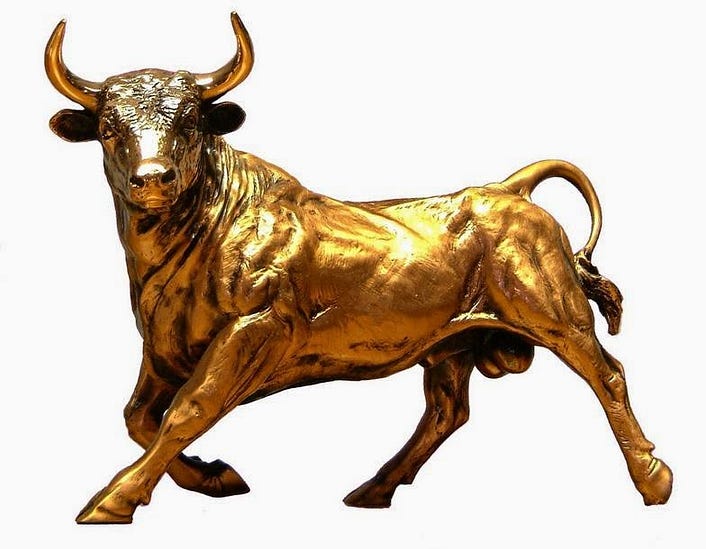
The letter ‘Lam’ depicts the sign of Taurus in the Quran. The astrological symbol of Taurus is the ‘bull’, and its characteristics include material wealth and abundance. Whilst dealing with the archetypal Taurus, the Quran teaches humans to control their desires of amassing material goods, and use their wealth in the service of some nobler objectives. The following verses give excellent descriptions of the sign.
And when Moses said unto his people: Lo! Allah commandeth you that ye sacrifice a cow, they said: Dost thou make game of us? He answered: Allah forbid that I should be among the foolish! (2, 67)
They said: Pray for us unto thy Lord that He make clear to us what (cow) she is. (Moses) answered: Lo! He saith, Verily she is a cow neither with calf nor immature; (she is) between the two conditions; so do that which ye are commanded. (2, 68)
They said: Pray for us unto thy Lord that He make clear to us of what colour she is. (Moses) answered: Lo! He saith: Verily she is a yellow cow. Bright is her colour, gladdening beholders. (2, 69)
They said: Pray for us unto thy Lord that He make clear to us what (cow) she is. Lo! cows are much alike to us; and lo! if Allah wills, we may be led aright. (2, 70)
(Moses) answered: Lo! He saith: Verily she is a cow unyoked; she plougheth not the soil nor watereth the tilth; whole and without mark. They said: Now thou bringest the truth. So they sacrificed her, though almost they did not. (2, 71)
In verse 67, Moses asked his people to metaphorically forgo the practices of accumulating wealth by sacrificing a cow, which would symbolize the characteristics of Taurus; but in verse 68, the people of Moses contended to defend their practices by asking questions that were meant to examine Moses’ knowledge of the sign of Taurus.
Those people were contending that Moses himself had no wealth, so how could he know the pain of forsaking it. Moses answered that in verse 68 by describing the position of Taurus in the zodiac by saying that the cow of Taurus was neither with a calf (twin characteristic of Gemini), nor immature (Aries characteristic); rather the sign had to be in between of the ‘Gemini’ and ‘Aries’. In verse 69, the yellow colour of the cow was described because of it being the colour of the metal copper of Taurus. Furthermore it is mentioned there, “Bright is her colour, gladdening beholders.”, because Taurus is the sign of spring season, as this time also bears blooming and colourful flowers to gladden the beholders.
But still the attachment of people with their wealth was so strong that they contended for more clues, and so were answered with the explanation of the element Earth of Taurus in the verse 71. It said that the cow was unyoked, meaning Taurus to be a sign of spring season; it did not labour on earth because the earth was already fertile; and without mark meant that it was a fixed sign that could not be influenced by the changing patterns of the seasons. Such were the descriptions of Taurus that people of Moses were left with no option but to reluctantly sacrifice the cow.
The prefixes with letter ‘Lam’ also appear in other chapters of the Quran, dealing with the archetypal properties of Taurus such as wealth management, usury, cow worship, greed, and materialism in the verses (2, 54), (2, 57), (2, 61), (2, 168), (2, 271- 276), (3, 130), (3, 180), (7, 130), (7, 148), and (7, 152).
The Letter ‘Mim’ (Gemini)
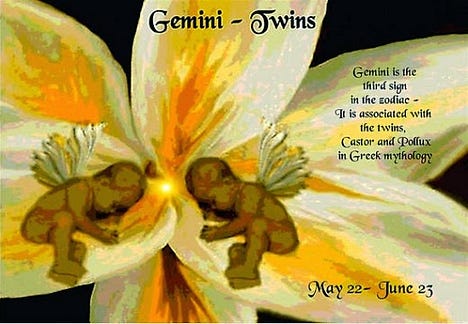
The Letter ‘Mim’ is used here to indicate the sign of Gemini in the Quranic chapters. The prefix appears in many chapters, but for the sake of illustration of the archetypal Gemini character, the following ritual has been commanded to be performed in the given verses.
Lo! (the mountains) Al-Safa and Al-Marwah are among the indications of Allah. It is therefore no sin for him who is on pilgrimage to the House (of God) or visiteth it, to go around them (as the pagan custom is). And he who doeth good of his own accord (for him), Lo! Allah is Responsive, Aware. (2, 158)
The mountains named ‘Al-Safa’ and ‘Al-Marwah’ mentioned here are allegorical representations of Gemini twins, Castor and Pollux. Whilst on the pilgrimage to Mecca, Muslims are required to run between those two mountains seven times for performing the ritual known as ‘Sai’. The story related to the origin of this ritual says that Abraham had left his wife Hagar with his infant son Ishmael as a spiritual trial for them in the desert. When Ishmael got thirsty and started to cry,
Hagar ran from one mountain top to another mountain top in order to catch sight of some passing caravan so as to procure drinking water. This she repeated seven times before getting back to Ishmael, thereby she found that a spring had broken forth from the place where the crying baby kicked the sand with his feet. Interestingly, Ishmael is also mentioned in Quran to describe the sign of Sagittarius, which is opposite to Gemini. Also, the rapid movement of Hagar between the two mountains is very characteristic of Mercury, the ruling planet of Gemini.
The Gemini properties with the prefix ‘Mim’ are also expressed in the verses (2, 102), (2, 221), (3, 61), (3, 195), (7, 127), (7, 141), (7, 189–190), (42, 11), (43, 12), (44, 58), (43, 3), and (41, 44).
The Letter ‘Sad’ (Cancer)

The astrological Sign of Cancer corresponds to the letter ‘Sad’ in the Quran. Cancer begins at summer solstice, and is ruled by the luminary planet Moon. In astrology, the Sun and the Moon represent King and Queen respectively, and therefore, Cancer is also one of the two royal signs. Here, the Quran talks about the ideals to be found in good governments by citing the example of king David.
And hath the story of the litigants come unto thee? How they climbed the wall into the royal chamber; (38, 21)
How they burst in upon David, and he was afraid of them. They said Be not afraid (We are) two litigants, one of whom hath wronged the other, therefore judge aright between us; be not unjust; and show us the fair way. (38, 22)
Lo! this my brother hath ninety and nine ewes while I had one ewe; and he said: Entrust it to me, and he conquered me in speech. (38, 23)
(David) said : He hath wronged thee in demanding thine ewe in addition to his ewes, and lo! many partners oppress one another, save such as believe and do good works, and they are few. And David guessed that We had tried him, and he sought forgiveness of his Lord, and he bowed himself and fell down prostrate and repented. (38, 24)
The two litigants of verse 21, who had broken into the royal chamber, allegorically represent the signs of Aries and Libra. The verse 22 states that the king David (Cancer) got afraid of the litigants (Aries and Libra), because those two signs were making a square angle to him. In verse 23, the ewes metaphorically represent the sign of Capricorn (opposite Cancer); and the litigant with the ninety nine ewes is Aries, whilst the one with a single ewe is Libra.
The Aries with its assertive and aggressive attitudes was trying to rob Libra even of a single ewe that it possessed. In verse 24, David (Cancer) used his royal authority to admonish Aries with regards to his behaviour, and also recognized the importance of the responsible use of power from this episode.
The characteristics of Cancer corresponding to the letter ‘Sad’ are also present in the verses (7, 94–102), (7, 106–108), (7, 145–146), (7, 157), (7, 160), (38, 2), (38, 5), (38, 17–20), (38, 25–26), and (38, 30).
The Letter ‘Ra’ (Leo)

The letter ‘Ra’ of Arabic language depicts the sign of Leo in the Quran. The sign of Leo is ruled by the Sun, as the choice of the word ‘Ra’ here is interesting since it is also the name of the ancient Egyptian solar deity. This word appears in connection to the story of Joseph in the Quran. The story says that Joseph was the brightest among his brothers, who out of jealousy were inclined to place him in the pit. The Quran says,
When Joseph said unto his father: O my father! Lo! I saw in a dream eleven planets and the sun and the moon, I saw them prostrating themselves unto me. (12, 4)
He said: O my dear son! Tell not thy brethren of thy vision. lest they plot a plot against thee. Lo! Satan is for man an open foe. (12, 5)
In the verses 4–5, Joseph (Leo) tells his father (Sun) that he saw ‘eleven planets’ that metaphorically represented eleven astrological signs (his brothers) besides Leo (himself). It is good to note here that in Greek mythology, the Sun god Apollo had been attributed with the characteristics of prophecy and vision. Apollo was known to be an oracular god, and as a patron of Delphi was responsible for the ‘Delphic Oracle’. Thus, the following visionary attributes of Joseph are also mentioned in the Quran.
O my Lord! Thou hast given me (something) of sovereignty and hast taught me (something) of the interpretation of events, Creator of the heavens and the earth! Thou art my Protecting Friend in the world and the Hereafter. Make me to die submissive (unto Thee), and join me to the righteous. (12, 101)
Also, the ability of Joseph to impart vision in darkness is described in the following verse.
Go with this shirt of mine (Joseph) and lay it on my father’s face, he will become ( again ) a seer; and come to me with all your folk. (12, 93)
Then, when the bearer of glad tidings came, he laid it on his face and he (Joseph’s father) became a seer once more. He said: Said I not unto you that I know from Allah that which ye know not? (12, 96)
Joseph became a lord in Egypt, which was acknowledged as an archetypal land of the kings at that time. Once together again with his father, he realized that his earliest dream had come to its realization.
And when they came in before Joseph, he took his parents unto him, and said: Come into Egypt safe, if Allah will! (12, 99)
And he placed his parents on the dais and they fell down before him prostrate, and he said: O my father! This is the interpretation of my dream of old. My Lord hath made it true, and He hath shown me kindness, since He took me out of the prison and hath brought you from the desert after Satan had made strife between me and my brethren. Lo! my Lord is tender unto whom He will. He is the Knower, the Wise. (12, 100)
The Letter ‘Kaf’ or ‘Qaf’ (Virgo)
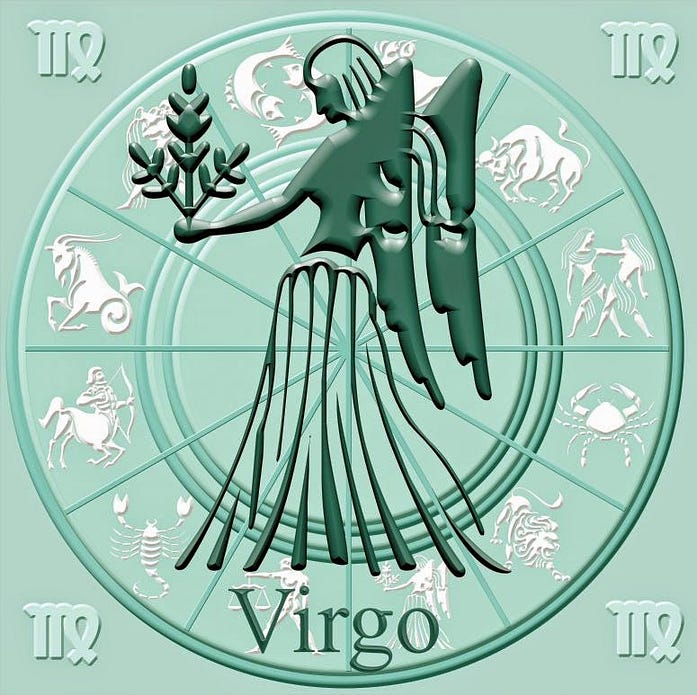
The letter ‘Kaf’ corresponds to the sign of Virgo, and is expressed in the Quran with a classic allegory of the mutable signs. ‘Mary’ in the following story of the Quran represents Virgo, as being a virgin she is responsible for the immaculate conception of Jesus.
And make mention of Mary in the Scripture, when she had withdrawn from her people to a chamber looking East. (19, 16)
And had chosen seclusion from them. Then We sent unto her Our spirit and it assumed for her the likeness of a perfect man. (19, 17)
She said: Lo! I seek refuge in the Beneficent One from thee, if thou art God fearing. (19, 18)
He said: I am only a messenger of thy Lord, that I may bestow on thee a faultless son. (19, 19)
She said: How can I have a son when no mortal hath touched me, neither have I been unchaste! (19, 20)
He said: So (it will be). Thy Lord saith: It is easy for Me. And (it will be) that We may make of him a revelation for mankind and a mercy from Us, and it is a thing ordained. (19, 21)
And she, conceived him, and she withdrew with him to a place. (19, 22)
And the pangs of childbirth drove her unto the trunk of the palm tree. She said: Oh, would that I had died ere this and had become a thing of naught, forgotten! (19, 23)
Then (one) cried unto her from below her, saying: Grieve not! Thy Lord hath placed a rivulet beneath thee. (19, 24)
And shake the trunk of the palm tree toward thee, thou wilt cause ripe dates to fall upon thee. (19, 25)
So eat and drink and be consoled. And if thou meetest any mortal, say: Lo! I have vowed a fast unto the Beneficent, and may not speak this day to any mortal. (19, 26)
The verse 16 of the above passage indicates that this story is regarding the sign of Virgo at the time when it rises at the eastern horizon. The trunk of the palm tree in the verse 23 is a metaphorical reference to the ‘mutable cross’ comprising of the signs of Virgo, Gemini, Pisces, and Sagittarius. In the verse 24, ‘one cried unto her from below her’ is Sagittarius, ‘rivulet beneath’ is Pisces, ‘ripened dates’ of the verse 25 is a reference to the sign of Gemini, whilst ‘Mary’ herself is a metaphor for the sign of Virgo. Also in the verse 26, the Mary (Virgo) gets her food from Gemini, her water from Pisces, and her consolation from Sagittarius.
The letter ‘Kaf’ or ‘Qaf’ is also described with the Virgo characteristics in the verses (42, 20), (42, 27), (42, 37), (50, 6), and (50, 9–10) of the Quran.
The Letter ‘Ha’ (Libra)
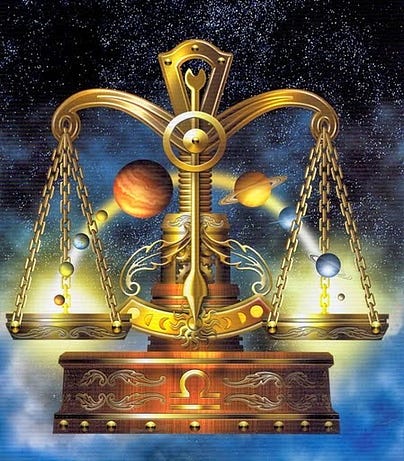
The letter ‘Ha’ expresses the Libra archetype of justice and good behaviour in the Quran. It is emphasized very strongly at many places as the most important and indelible principle in nature. Usually, the iniquitous are admonished of a blazing ‘fire’ as their punishment, which is the element of the opposite sign of Aries.
And (make mention of) the day when the enemies of Allah are gathered unto the Fire, they are driven on. (41, 19)
Till, when they reach it, their ears and their eyes and their skins testify against them as to what they used to do. (41, 20)
And they say unto their skins: Why testify ye against us? They say: Allah hath given us speech Who giveth speech to all things, and Who created you at the first, and unto Whom ye are returned. (41, 21)
Ye did not hide yourselves lest your ears and your eyes and your skins should testify against you, but ye deemed that Allah knew not much of what ye did. (41, 22)
The verses 19–22 is an example of the self evident demonstration of the divine justice in nature. Furthermore, the verse 19 of the Quran by mentioning the phrase ‘enemies of Allah’ is also making a political standpoint against those collectivist groups who use ideologies or slogans to indoctrinate the ignorant masses of people.
These masses than act as a mammoth creature (a state) with its own currency (blood), and social structure (body). Once the head of this creature gets drugged, than the body can be compromised or paralyzed, and therefore those body parts act as witnesses against the head. The themes of justice are also expressed in the verses (42, 32–34), (42, 40–43), (40, 46–50), and similarly in the following verses.
Whoso doeth right, it is for his soul, and whoso doeth wrong, it is against it. And afterward unto your Lord ye will be brought back. (45, 15)
Whoso doeth right it is for his soul, and whoso doeth wrong it is against it. And thy Lord is not at all a tyrant to His slaves. (41, 46)
The Letter ‘Ya’ (Scorpio)

The sign of Scorpio is depicted in the Quran with the letter ‘Ya’. Astrologically, Scorpio on the one hand deals with the extreme human behaviours such as sex, subversion, death, and destruction; whilst on the other hand it embodies the principles of regeneration, rejuvenation, reproduction, and a sanguine existence. Quran describes the sign of Scorpio in the following style.
And a token unto them is that We bear their offspring in the laden ship. (36, 41)
And have created for them of the like thereof whereon they ride. (36, 42)
And if We will, We drown them, and there is no help for them, neither can they be saved. (36, 43)
Unless by mercy from Us and as comfort for a while. (36, 44)
When it is said unto them: Beware of that which is before you and that which is behind you, that haply ye may find mercy (they are heedless). (36, 45)
The verses 41–44 can be called as the euphemistic descriptions of human sexuality. In verse 41, the ‘laden ship’ is a metaphor for a mother’s womb; the verse 42 says that babies inside the mother are in the same state as on a sailing ship; and the verses 43–44 state that due to the watery environment of the mother’s womb, the babies could also be made to drown. The verse 45 relates the guidance for humans to be aware of the Scorpio attitudes in life. Quran also states,
Hath not man seen that We have created him from a drop of seed? Yet lo! he is an open opponent. (36, 77)
And he hath coined for Us a similitude, and hath forgotten the fact of his creation, saying: Who will revive these bones when they have rotted away? (36, 78)
Say: He will revive them Who produced them at the first, for He is Knower of every creation. (36, 79)
In verses 77–79, the positive attributes of Scorpio as being a sign of rebirth and regeneration is emphasized. The sign is also allegorically mentioned in the verses (36, 47), (36, 36–40), (36, 51–52), and (36, 66–68).
The Letter ‘Ain’ (Sagittarius)
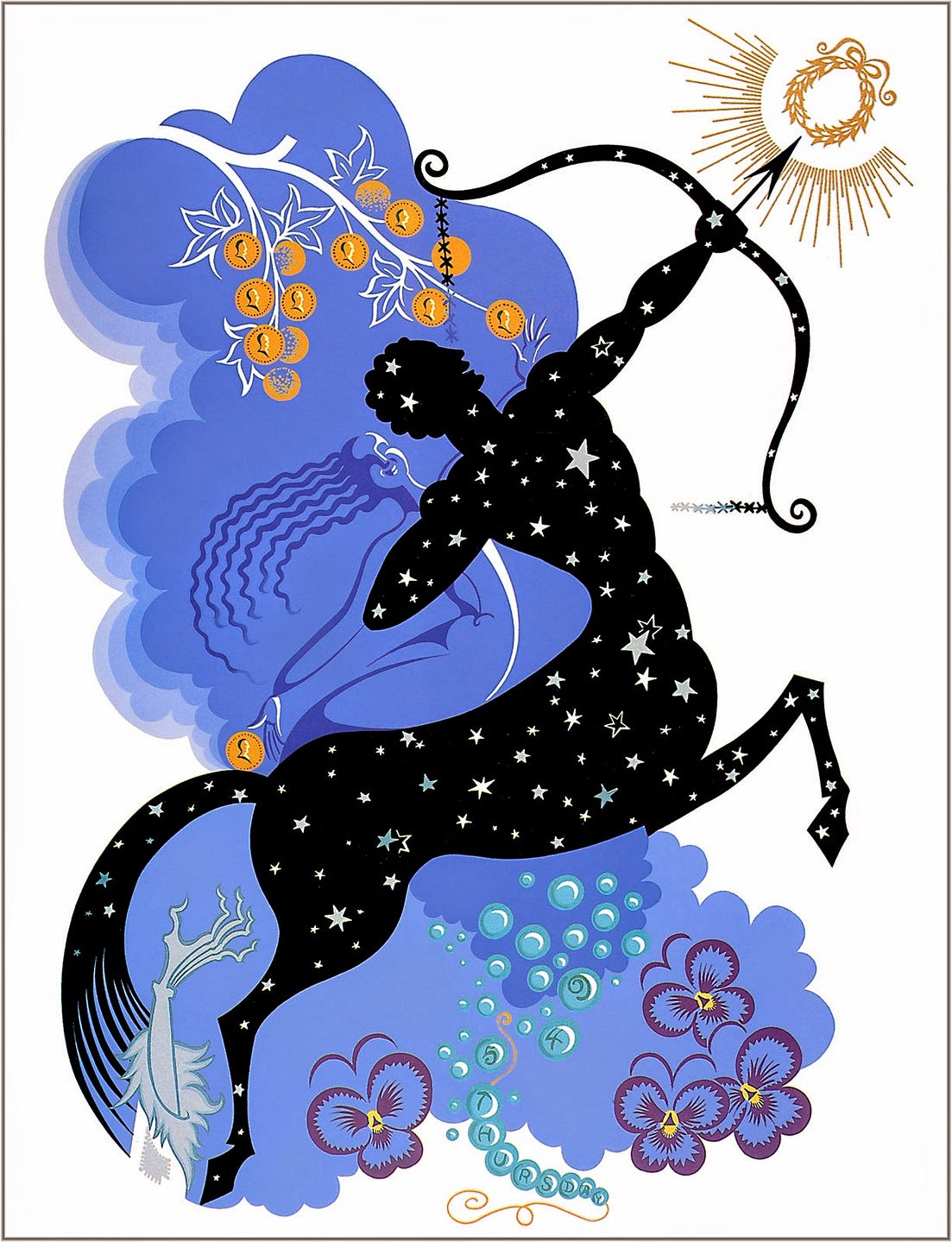
The letter ‘Ain’ in the Quran represents the sign of Sagittarius. The symbol of Sagittarius in astrology is that of a celestial archer who shoots an arrow towards the heavens. Thus, Sagittarius characteristics include exploration of the universe by travelling to exotic areas, and experiencing novelty in lifestyles. Sagittarius is also keen to participate in the intellectual discoveries and philosophical endeavours. The Quran describes the sign by mentioning its attributes in the following fashion.
And make mention in the Scripture of Ishmael. Lo! he was a keeper of his promise, and he was a messenger (of Allah) a Prophet. (19, 54)
He enjoined upon his people worship and alms giving, and was acceptable in the sight of his Lord. (19, 55)
And We raised him to high station. (19, 56)
The character of Ishmael is a metaphor for Sagittarius in the Quran. Even in Judeo-Christian traditions, Ishmael son of Abraham is described as an ‘archer’ or ‘hunter’, which symbolically befits the sign of Sagittarius. In the verse 55, ‘the sight of his Lord’ is mentioned in connection to Ishmael, which is not stated regarding any other prophet. Also, in the verse 56 ‘high station’ should represent the higher consciousness, which is the very emblem of Sagittarius. Similarly, the talent of observation is stated in the following verses.
Allah increaseth in right guidance those who walk aright, and the good deeds which endure are better in thy Lord’s sight for reward, and better for resort. (19, 76)
Hast thou seen him who disbelieveth in Our revelations and saith: Assuredly I shall be given wealth and children! (19, 77)
Hath he perused the Unseen, or hath he made a pact with the Beneficent? (19, 78)
And how many a generation before them have We destroyed! Canst thou (Muhammad) see a single man of them, or hear from them the slightest sound? (19, 98)
The Letter ‘Ta’ (Capricorn)
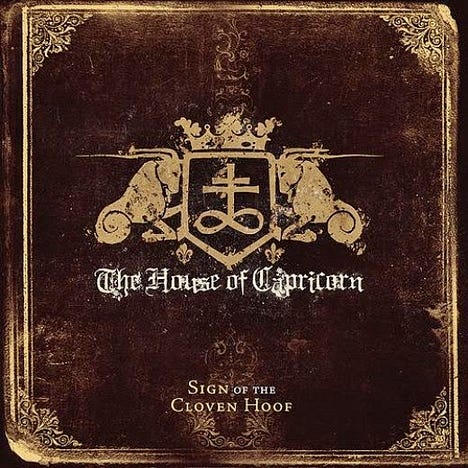
The letter ‘Ta’ depicts the sign of Capricorn in the Quran. Capricorn starts at the winter solstice, and therefore, it is the sign where the royalties struggle, as it is also opposite to the sign of Cancer. Furthermore, there is a relationship between the letters ‘Sad’ of Cancer, and ‘Ta’ of Capricorn; because the hieroglyph of letter ‘Sad’ seems like that of a snake with its head above the tail, whilst the hieroglyph of letter ‘Ta’ is that of a snake with its tail above the head. In the ancient Egypt, the straight cobra was known as ‘Uraeus’, and it used to symbolize the sovereignty, royalty, and divine authority. That is why it appears on the foreheads of ancient Egyptian royalties in their pictures and statues. In Quran, the story of Capricorn is stated in the following fashion.
And what is that in thy right hand, O Moses? (20, 17)
He said: This is my staff whereon I lean, and wherewith I beat down branches for my sheep, and wherein I find other uses. (20, 18)
He said: Cast it down, O Moses! (20, 19)
So he cast it down, and Lo! it was a serpent, gliding. (20, 20)
He said: Grasp it and fear not. We shall return it to its former state. (20, 21)
And thrust thy hand within thine armpit, it will come forth white without hurt. (That will be) another token. (20, 22)
That We may show thee (some) of Our greater portents. (20, 23)
Go thou unto Pharaoh! Lo! he hath transgressed (the bounds). (20, 24)
In the verse 18, Moses described his staff that was used by him as a tool for helping him in the struggles of life. In verse 20, the staff which was used for menial tasks became a serpent, showing that Moses had talents for the greater works, but he was rather wasting his life out in drudgery. In the verse 21, Moses got encouragement to realize his talents, and not be afraid of himself. The white hand in the verse 22 is a metaphorical reference to the ‘Moon’.
Symbolically, these verses are saying that Moses was the true lunar royalty (Cancer), but due to his lack of self realization, Pharaoh had taken over the government, and was acting like a tyrant because of his undeserved status. Therefore, the verse 24 commanded Moses to strive in order to reclaim his lost reign. Also in the Quran, wherever letter ‘Ta’ appears, the mention of Moses and his affairs always follow.
The Letter ‘Sin’ (Aquarius)
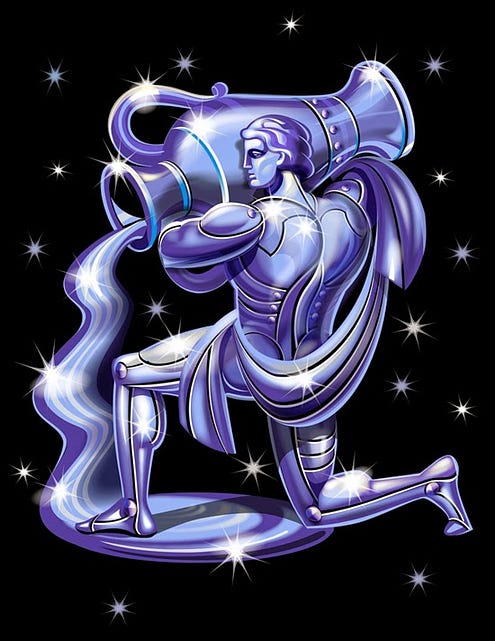
The letter ‘Sin’ represents the sign of Aquarius in the Quran. Aquarius is opposite Leo, which is the sign ruled by the Sun, and therefore, Aquarius receives the least amount of light or minimal attention. As a result, it is the least formal of all the signs, because formality in a behaviour results from the impression one may make on others.
Since in Aquarius there is no light/attention, hence formality is basically out of question here. Aquarius is the sign of an individual who finds himself free from cultural restrictions to express his uniqueness in the best possible way. It is the sign of the anonymous individuals because they do not need any identity to exist; as opposed to Leo which is the sign of the king who would require to chart his whole ancestral lineage to express his personality. The Quran states the following regarding this sign.
Coin for them a similitude: The people of the city when those sent (from Allah) came unto them; (36, 13)
When We sent unto them twain, and they denied them both, so We reinforced them with a third, and they said; Lo! we have been sent unto you. (36, 14)
They said: Ye are but mortals like unto us. The Beneficent hath naught revealed. Ye do but lie! (36, 15)
They answered: Our lord knoweth that we are indeed sent unto you. (36, 16)
And there came from the uttermost part of the city a man running. He cried: O my people! Follow those who have been sent! (36, 20)
Follow those who ask of you no fee, and who are rightly guided. (36, 21)
Ah, the anguish for the bondmen! Never came there unto them a messenger but they did mock him! (36, 30)
In the verse 13, ‘the people of the city’ is a reference to the sign of Leo, and ‘those sent (from Allah)’ is a reference to Aquarius. It is saying here that when city people who were used to the traditional attitudes, had come across the anonymous individuals with significantly radical or revolutionary information, they rejected them on account of their cultural values, and formality based behaviours. The verse 14 states that the information of those two individuals got further confirmed by a third anonymous individual. In the verse 20, ‘man from uttermost part of the city’ is a reference to the least formal member of that city who could judge the message of those individuals in an unbiased fashion. The verse 30 indicates that formality and traditional attitudes among people (bondmen) stymie the human progress towards the higher goals.
The Letter ‘Nun’ (Pisces)

The letter ‘Nun’ represents the sign of Pisces in the Quran. Astrologically, Pisces is the sign of rest, recuperation, and healing. Therefore, it embodies the behaviours of selflessness, generosity, and goodness. It is the sign of spiritual mystics who would dance to the tune of the cosmos by submitting themselves to the natural flow of currents. It is also the sign of the intuitive type intelligent people who would never make decisions only on the basis of logic or analyses, but rather give their hearts the go at everything. Here, Quran explains the good attributes of Pisces by stating a story of the anti-Pisces behaviours.
Lo! we have tried them as We tried the owners of the garden when they vowed they would pluck its fruit next morning. (68, 17)
And made no exception (for the will of Allah); (68, 18)
Then a visitation came upon it while they slept. (68, 19)
And in the morning it was as if plucked. (68, 20)
And they cried out one unto another in the morning. (68, 21)
Saying: Run unto your field if ye would pluck (the fruit). (68, 22)
So they went off, saying one unto another in low tones: (68, 23)
No needy man shall enter it today against you. (68, 24)
They went betimes, strong in (this) purpose. (68, 25)
But when they saw it, they said: Lo! we are in error! (68, 26)
Nay, but we are desolate! (68, 27)
The best among them said: Said I not unto you: Why glorify ye not (Allah)? (68, 28)
They said: Glorified be our Lord! Lo! we have been wrong doers. (68, 29)
Then some of them drew near unto others, self reproaching. (68, 30)
They said: Alas for us! In truth we were outrageous. (68, 31)
In the above story, the consequences of selfishness, greed, and narrow-mindedness is described. It also explains that there is always more to the human lives than the mere materialistic tendencies, and those who fail to recognize the essential human values deserve due criticism. The Quran also states,
On the day when it befalleth in earnest, and they are ordered to prostrate themselves but are not able. (68, 42)
With eyes downcast, abasement stupefying them. And they had been summoned to prostrate themselves while they were yet unhurt. (68, 43)
In verses 42–43, the rigidity in human attitudes is severely rebuked. It is saying that when people are asked to adopt a good behaviour whilst they are capable of it, they usually choose the wrong side. Once their option gets to be expired, and they can see the tragic consequences of their choices than they are unable to make amends. But still there are few who catch the light before it is too late, as explained in the following verses.
But wait thou for thy Lord’s decree, and be not like him of the fish, who cried out in despair. (68, 48)
Had it not been that favour from his Lord had reached him he surely had been cast into the wilderness while he was reprobate. (68, 49)
But his Lord chose him and placed him among the righteous. (68, 50)
In the verse 48, ‘like him of the fish’ is referred to Jonah, but actually it is a metaphor for the sign of Pisces. The verses 49–50 are actually saying that the archetypal behaviour of Pisces can deliver one from the conditions of despair.
Steve Ramsey.


